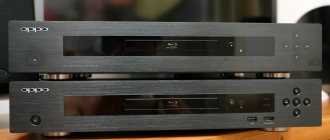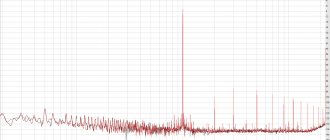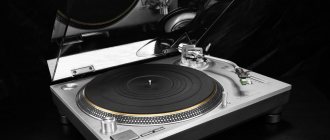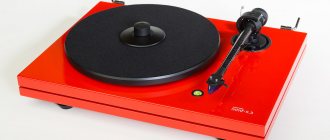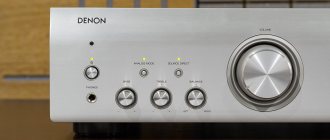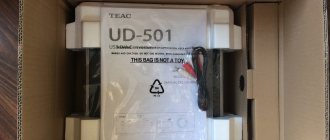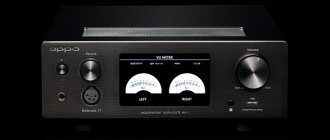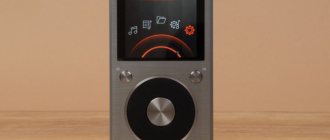The fact that OPPO makes excellent video players is no longer in doubt. The company has been a leader for many years, and its new UHD player UPD-203 has earned from our expert an immodest rating of “the best,” which we rarely give. And since the 205th model in its video part completely repeats the 203rd, I won’t talk about the video capabilities of the new product in this test. Moreover, I will think of the UDP-205 as a universal audio player, because here it is competing in a very competitive market segment.
Hyperstream
The key element of any modern audio player is the DAC. And in this, OPPO UDP-205 will give odds to even expensive models of network players and individual DACs. How many devices do you know that are equipped with professional ES9038PRO chips from ESS Saber, and even two at once, separately for stereo and separately for multi-channel outputs? Those who like to watch concerts from Blu-ray, I think, already liked this approach. However, connoisseurs of classic stereo can also rejoice: the stereo output has a fully balanced architecture, starting with the DAC itself.
Two professional DACs, balanced stereo output, linear power supply. There is a lot to see here!
In addition to its honorable role as the flagship of the ESS Saber line, 32-bit resolution and the presence of eight channels in one chip, the ES9038PRO DAC is notable for its record high signal-to-noise ratio (140 dB) and extremely low distortion level - -122 dB. But the most important thing is the use of the original Hyperstream digital-to-analog conversion algorithm. A jitter suppression system is integrated into the circuit and the level of its own noise is reduced, as a result the depth of signal processing and conversion accuracy increase when compared with conventional Delta-Sigma circuitry.
Model features
Actually, it is the new DAC, which is the latest development of the ESS Saber, that is the main competitive advantage of the model. This is not the first time that a Chinese manufacturer has significantly expanded the functionality and capabilities of its own product, thereby taking it beyond the usual boundaries and increasing its competitiveness.
UDP 205 is not just another network player, but also a full-fledged music player. You can even temporarily forget about how well the device can play video and use it exclusively for playing music, connecting it to high-quality acoustics and an amplifier.
However, who said that sound is not so important in films? Film lovers value not only picture quality, but also sound. The UPD 203 player, which is the junior member of the line, is also capable of good sound quality, but the UPD 205 model pays special attention to sound. It only remains to add that the player has not one, but two ES9038PRO chips installed. One is responsible for working with stereo output, while the second is responsible for working with multi-channel output.
But let's return for a moment to the video capabilities, since they obviously attract the attention of potential buyers. The MediaTek OP8591 chipset, created specifically for OPPO, is responsible for video processing. You won't find it in products from other companies. The chipset is interesting because it can perfectly cope with video files of all common formats and resolutions, providing excellent image quality.
This is one of the first chipsets to support the Dolby Vision standard. By the way, updated firmware is already available for models 203/205, which adds support for Dolby Vision. The player is capable of reproducing video signals in the HDR range. Of course, there is full support for the Ultra HD Blu-ray format.
The model has extensive network capabilities and is capable of receiving content via both wired and wireless networks. The Wi-Fi antennas are hidden inside the case; there are no external dongles anymore, and that’s a plus.
Design
The design of the UPD 205 almost completely repeats the solutions that were used in its predecessor - the BDP-105D model. The boards are arranged in a U shape around the drive; there is no active cooling system. The lid has numerous ventilation holes through which warm air is removed. However, even when playing Blu-ray discs or “heavy” network content, the temperature inside the case increases slightly. The device operates almost silently.
Housing materials and dimensions
The case is metal, only the controls and individual components of the connectors present on the rear panel are plastic. The width is standard - the device can be easily installed in a rack. The dimensions of the model are 430x311x123 mm. Weight – 10 kg. The device is noticeably heavier and larger than the younger model UDP 203.
Build quality
Traditionally, there are no complaints about the build quality. The model is assembled at the level of the best representatives of the Hi-End class.
Positioning
The UDP 205 tops OPPO's line of network players, replacing the outdated BDP-105D. This is the company's flagship and, probably, it will remain so until the advent of a new generation of devices. Perhaps one or two modifications of the device will appear (for example, the Oppo 205d - with a Darbee Visual Presence video processor), but there is no exact information on this yet. So, if you need a player that supports the current UHD Blu-ray format, and you don't want to change it in the next 5 years, the UDP 205 is a good choice.
When promoting the device on the market, OPPO places special emphasis on its capabilities for sound reproduction, which is logical, because the video part remains the same as in the younger model. In many reviews, special attention is paid to the sound of the player. We will once again note the versatility of the Chinese company’s products.
Sources
There are indecently many ways to use the OPPO UDP-205 as an audio device. It itself can act as a USB or regular DAC, play CD, SACD and DVD-Audio, has several USB ports for reading files from flash drives and hard drives, and plays files over the network. To top it all off, the device has digital outputs (in case you suddenly want to use an external DAC already present in your system).
You can install not only Blu-ray discs, but any discs. Even DVD-Audio, if you have them in stock somewhere
At this point, it would not be amiss to point out that the player’s built-in DAC has seven digital filter modes, each of which gives the sound specific shades. Multiply this by the possible number of scenarios in which the built-in DAC will be used, and you understand the complexity of the situation in which I found myself. Given the variety of connection and configuration options available, testing the OPPO UDP-205 could take a lot of time, so I highlighted the main scenario for using the new product. I think that the player will replace the previous source, both disk and digital/network. Therefore, we will take CD and SACD as a basis, as well as files from USB and local network storage. But before we start listening, let's understand the settings and controls.
Impressions and conclusions
Usually, at the end of the review, we analyze all the pros and cons, trying to find out how critical the identified disadvantages are and whether we can turn a blind eye to them. In the case of UDP 205 there are no disadvantages. It would be a stretch to consider the artificial limitation on the playback of some formats (ISO and BDMV) as a minus, but it’s hard to blame OPPO for this. The player is supplied to the international market, so it is logical that the Chinese manufacturer seeks to protect itself from possible lawsuits from copyright holders.
This is one of the best video players we've ever reviewed.
pros
• High-quality DAC • High build quality • Extensive set of inputs/outputs • “Omnivorous” • Great picture • Convenient mobile application • Reasonable price
Minuses
• Loss of warranty when installing alternative firmware
Player reviews
There are a lot of reviews about the model. It is often purchased as a central component for a home theater. We have not encountered any negative comments about the player.
Control
If we consider the OPPO UDP-205 as an audio player, its own remote control becomes a rather useless device. This is because it is much more convenient to play files from media connected via a network or via a USB port using a proprietary application than by using a TV and remote control.
The names of digital filters are picturesque, but not everyone understands them
I’ll add to this that turning off the video part and the Pure Audio mode, which turns off, among other things, the device’s display, give a noticeable increase in sound quality. The only situation in which the remote seems appropriate is when listening to a CD or SACD.
The smartphone can completely replace the player’s own remote control and is very convenient when working with files
The player's audio settings resemble those in a regular Blu-ray player or AV receiver. You can select the speaker size, distance, set cutoff frequencies for the subwoofer, and so on.
A large and convenient remote control will be needed when you listen to CDs
Among the subtleties, it is worth noting the switchable ability to adjust the volume from the remote control or from the application, separate volume control for the headphone output, and the most important highlight - the ability to select digital filters. The filtering mode changes on the fly, so it’s very convenient to catch nuances.
Player specifications
Main characteristics:
- Video processor OP8591
- Wireless Wi-Fi adapter (802.11 a/b/g/n/ac, 2.4/5 GHz)
- Ethernet (LAN 100/1000 Mbit/s)
- Compatible with DLNA, SMB servers
- Matrix display
- Maximum audio quality (in USB DAC mode): PCM 32bit/768kHz, DSD 22.5792
- Frequency range: 20-160000 Hz (-3/+0.5 dB)
- Signal-to-noise ratio: >120 dB
- Distortion: <0.00018
- Dimensions 430x311x123 mm
- Weight 10 kg
Connectors
Outputs:
- Analog, Audio: 7.1ch, 5.1ch, Stereo
- Balanced (XLR) and stereo (RCA)
- Coaxial/optical digital audio
- HDMI audio
- HDMI video
Inputs:
- HDMI audio
- HDMI video
- USB audio
- Coaxial/optical digital audio
From the first notes
The test system consisted of a Schiit Ragnarok amplifier connected to the player with balanced cables, and Sonus Faber Olympica III acoustics. As you can see, the level is high, allowing you to appreciate the nuances of the sound of the source.
Even with a superficial acquaintance with the OPPO UDP-205, it is obvious that the detail, intonation accuracy, dynamics, stage alignment and transmission of “air”, as well as many other little things noticeable only on high-quality equipment, correspond to what you expect from an SACD or network player comparable cost. Meanwhile, we have before us a universal device for which playing music is one of its many functions!
And the design of OPPO UDP-205 is quite in the style of High-End components. Which, by the way, is what he is.
Speaking of functions. I compared the sound of the same composition when played over the network, from a flash drive and from a CD. In good conditions, when the local network is not overloaded and the optical disc is not scratched, the difference in sound balances somewhere on the verge of self-hypnosis. Sometimes it seemed that the same track sounded a little more complete from a flash drive, but I would not have been able to clearly distinguish one from the other blindly. But it’s quite easy to distinguish DSD or Hi-Res FLAC from regular FLAC or WAV with a resolution of 16 bits/44.1 kHz (or SACD from CD). This is immediately noticeable in the richness of the timbres, in the lightness and freedom of the sound of the upper frequencies and in the general feeling of the fullness of the sound.
And again a view from the inside to enjoy the technical perfection. Note the symmetry of the stereo output
The operating modes of the digital filter are also quite noticeable. In one case, the sound seems harsh and abrupt, and in the other, it flows smoothly and represents a single whole. The latter is characteristic of phase-linear modes - they, in my opinion, successfully complement the sound signature of the player.
The OPPO UDP-205 performs any composition expressively and effectively, but all attention is directed to the artistic component of the music. The unified sound of the middle and the player’s desire to smooth out rough moments and make the sound more comfortable do not allow me to delve into the details. The idea arose that the manufacturer deliberately chose this balance between musicality, comfort and sound quality in order to please the majority of users, not all of whom are audiophiles.
Even the cables in critical places are very audiophile. Do you see two “sugar cubes” on the boards? Below them are the same professional DACs from ESS Saber
Don't think that the sound of this player will be genre specific or not informative enough. Even if you are a fan of modern academic music, metal, progressive rock or free jazz, you will most likely evaluate the OPPO UDP-205 positively. First of all, thanks to excellent macro- and microdynamics, as well as the ability to extract new details and shades of sounds from already familiar recordings. Overall, the OPPO UDP-205 handles complex music well. Neither multi-layered rhythmics nor polyphony are a problem for him. You are more likely to get bored when listening to simple pop music with monotonous melody and a low level of dynamic range.
It is noteworthy that there are digital inputs that allow you to use the player as a DAC
The OPPO UDP-205 builds a realistic scene, strictly in accordance with the source material. This is easy to hear if you change songs frequently (which is what we do during the test). Either a small recording room on a raw track fresh from the studio, or a huge space of a concert hall with a symphony line-up in the orchestra pit. This is a clear indication of how high quality sound this device offers. But at the same time, you understand that an audiophile will find untapped potential in it, so upgrading the UDP-205 in capable hands cannot be avoided.
